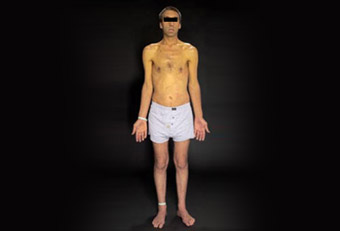黄疸是由胆红素在血流中累积,继而在皮肤、巩膜和黏膜中沉积引起的。总胆红素的正常范围是 3.4-20μmol/L(0.2-1.2mg/dL)。黄疸可能在临床上不明显,直到血清水平超过 51μmol/L(3mg/dL)。
阅读更多黄疸的病因可能相当难辨别。针对性的病史和体格检查最重要。大约 85% 的患者可以使用此方法进行准确诊断。[1]Greenberger NJ. History taking and physical examination for the patient with liver disease. In: Schiff ER, Sorrell MF, Maddrey WC, eds. Schiff's diseases of the liver. 9th ed. Philadelphia, PA: Lippincott, Williams & Wilkins; 2003:3-5.
病毒性肝炎(甲型至戊型)
病毒性甲型肝炎、病毒性乙型肝炎、病毒性丙型肝炎、病毒性丁型肝炎和病毒性戊型肝炎都有可能引起黄疸。
在急性肝炎中,甲型肝炎的相对发生率在西方国家已有下降。卫生、公共医疗制度和公共卫生的改善对甲型肝炎的发病率产生最大影响。疫苗接种和被动免疫已在高危人群中一定程度地降低了发病率。
乙型肝炎病毒(HBV)经常会引起急性肝炎,并且是全世界慢性肝炎的最常见病因。乙型肝炎病毒经由血液和性传播。乙型肝炎病毒感染会引起复杂的病毒-宿主相互作用,进而引起急性症状性疾病或无症状性疾病。
丙型肝炎病毒 (HCV) 是西方国家慢性病毒性肝炎的主要病因。丙型肝炎病毒感染者中仅少数为自限性疾病。约 70-80% 的丙型肝炎病毒感染患者会发展为慢性感染。20% 的慢性感染患者会在疾病发作后的 20 年内出现肝硬化。
丁型肝炎病毒是一种缺陷性病毒,需要在感染乙型肝炎病毒时,才引起临床疾病。
在全球范围内,戊型肝炎病毒 (HEV) 是急性病毒性感染的最常见病因。该病毒起初被认为不会在发达国家发生,但是近期的报告显示这种概念是错误的。
HIV
已知 HIV 感染者代表一类独特的有多种可能造成黄疸病因的人群。[2]Poles MA, Lew EA, Dieterich DT. Diagnosis and treatment of hepatic disease in patients with HIV. Gastroenterol Clin North Am. 1997;26:291-321.http://www.ncbi.nlm.nih.gov/pubmed/9187926?tool=bestpractice.com丙型肝炎病毒或乙型肝炎病毒合并感染的病例并不少见。高效抗逆转录病毒疗法 (HAART) 是药物性肝炎的病因之一。各种机会性感染和恶性肿瘤都会引起 HIV 感染患者的肝胆病理。尸检研究显示,HIV 感染患者的感染或恶性肿瘤发病率为 33-78%,感染微生物很多,从病毒(CMV 和 HSV)到肉芽肿(鸟分枝杆菌复合体),再到真菌等。[2]Poles MA, Lew EA, Dieterich DT. Diagnosis and treatment of hepatic disease in patients with HIV. Gastroenterol Clin North Am. 1997;26:291-321.http://www.ncbi.nlm.nih.gov/pubmed/9187926?tool=bestpractice.com
药物性肝炎
在因肝功能障碍而入院治疗的患者中,药物性肝炎的发病率是 0.8-1.5%。[3]Galan MV, Potts JA, Silverman AL, et al. The burden of acute nonfulminant drug-induced hepatitis in a United States tertiary referral center. J Clin Gastroenterol. 2005;39:64-67. [Published correction appears in J Clin Gastroenterol. 2005;39:176.]http://www.ncbi.nlm.nih.gov/pubmed/15599214?tool=bestpractice.com[4]Marti L, Del Olmo JA, Ornia E, et al. Clinical evaluation of drug-induced hepatitis. Rev Esp Enferm Dig. 2005;97:258-265.http://www.ncbi.nlm.nih.gov/pubmed/15982181?tool=bestpractice.com[5]Meier Y, Cavallaro M, Roos M, et al. Incidence of drug-induced liver injury in medical inpatients. Eur J Clin Pharmacol. 2005;61:135-143.http://www.ncbi.nlm.nih.gov/pubmed/15726344?tool=bestpractice.com[6]Pendino GM, Mariano A, Surace P, et al. Prevalence and etiology of altered liver tests: a population-based survey in a Mediterranean town. Hepatology. 2005;41:1151-1159.http://onlinelibrary.wiley.com/doi/10.1002/hep.20689/fullhttp://www.ncbi.nlm.nih.gov/pubmed/15841464?tool=bestpractice.com这个数字很低,但具有误导性,因为其病死率约为 10%。[7]Andrade RJ, Lucena MI, Fernandez MC, et al. Drug-induced liver injury: an analysis of 461 incidences submitted to the Spanish registry over a 10-year period. Gastroenterology. 2005;129:512-521.http://www.ncbi.nlm.nih.gov/pubmed/16083708?tool=bestpractice.com[8]Bjornsson E, Olsson R. Outcome and prognostic markers in severe drug induced liver disease. Hepatology. 2005;42:481-489.http://www.ncbi.nlm.nih.gov/pubmed/16025496?tool=bestpractice.com
炎症性肠病
大约 3-6% 的溃疡性结肠炎患者和 1.2% 的克罗恩病患者将会患原发性硬化性胆管炎,它是胆管狭窄和扩张的病因,继而进展为黄疸。[9]Kelly P, Patchett S, McCloskey D, et al. Sclerosing cholangitis, race and sex. Gut. 1997;41:688-689.http://www.ncbi.nlm.nih.gov/pubmed/9414979?tool=bestpractice.com[10]Tobias R, Wright J, Kottler R, et al. Primary sclerosing cholangitis associated with inflammatory bowel disease in Cape Town, 1975-1981. S Afr Med J. 1981;63:229-235.http://www.ncbi.nlm.nih.gov/pubmed/6823639?tool=bestpractice.com这些患者患胆管癌的风险也较高(终生风险约为 18-20%),胆管癌是引起黄疸的又一病因。
恶性、机械或血液学病因
此外,黄疸还可能会继发于恶性肿瘤,例如肝细胞癌或胰腺癌。机械性梗阻(如胆总管结石病)或镰状细胞贫血也可能引起黄疸。

